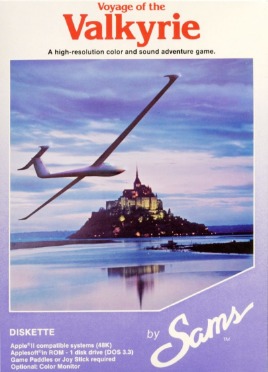
Nim is a mathematical game of strategy in which two players take turns removing objects from distinct heaps or piles. On each turn, a player must remove at least one object, and may remove any number of objects provided they all come from the same heap or pile. Depending on the version being played, the goal of the game is either to avoid taking the last object or to take the last object.

The TRS-80 Micro Computer System is a desktop microcomputer launched in 1977 and sold by Tandy Corporation through their Radio Shack stores. The name is an abbreviation of Tandy Radio Shack, Z80 [microprocessor]. It is one of the earliest mass-produced and mass-marketed retail home computers.
Idle animations are animations within video games that occur when the player character is not performing any actions. They serve to give games personality, as an Easter Egg for the player, or for realism.

Adventureland is a text adventure video game for microcomputers, released by Scott Adams in 1978. The game has no plot but simply involves searching for thirteen lost artifacts in a fantasy setting. Its success led Adams to form Adventure International, which went on to publish thirteen similar games in the Adventure series, each in different settings.

Tanglewood is a puzzle/adventure computer game published by Microdeal for the Dragon 32 and TRS-80 Color Computer in early 1987. It was released for the Atari ST and Amiga in 1988.

SoftSide is a defunct computer magazine, begun in October 1978 by Roger Robitaille and published by SoftSide Publications of Milford, New Hampshire.

Penetrator is a 1982 ZX Spectrum video game made by Melbourne House programmers Philip Mitchell and Veronika Megler. The game is a clone of Konami's 1981 Scramble arcade game. Penetrator was ported to the TRS-80 and Commodore 64.

The TRS-80 Model 4 is the last Z80-based home computer family by Radio Shack, sold from April 1983 through late 1991.

Time Traveler is a 1980 fantasy text adventure developed by Krell Software. The game was released on the 16K, Level II TRS-80, Apple II, Commodore PET, and Atari 8-bit family

The Motorola DROID 3 is a smartphone released on July 7, 2011, by Verizon Wireless running the Android 2.3 operating system by Google. It comes with 16 GB of internal storage. The smartphone does not ship with a microSD card. It has a 4-inch qHD display and an 8-megapixel camera capable of recording 1080p video. Unlike the DROID 2, the Motorola DROID 3 features a 5-row QWERTY keyboard, with a dedicated number row. It also has a VGA front-facing camera for video calls. The Droid 3 ships with Android 2.3.4 (Gingerbread) with Motorola's updated proprietary Motoblur UI. Like other contemporary Motorola phones, it has a locked bootloader, but it can have a custom rom using SafeStrap.
The TRS-80 computer manufacturered by Tandy / Radio Shack contains an 8-bit character set. It is partially derived from ASCII, and shares the code points from 32 - 95 on the standard model. Code points 96 - 127 are supported on models that have been fitted with a lower-case upgrade.
Space Games-3 is a 1980 video game by Creative Computing for the TRS-80 Model I Level II.

FS1 Flight Simulator is a 1979 video game published by Sublogic for the Apple II. A TRS-80 version followed in 1980. FS1 Flight Simulator is a flight simulator in the cockpit of a slightly modernized Sopwith Camel. FS1 is the first in a line of simulations from Sublogic which, beginning in 1982, were also sold by Microsoft as Microsoft Flight Simulator.

Computer Acquire is a 1980 video game published by Avalon Hill for the Apple II, Atari 8-bit family, Commodore PET, and TRS-80.

Voyage of the Valkyrie is a video game for the TRS-80 and Apple II published in 1981 by Advanced Operating Systems. It was written by Leo Christopherson.
Trek-80 is a text-based video game written by Steve Dompier in 1976 and sold by Processor Technology for their Sol-20 computer and suitable S-100 bus machines.

Galaxy is a 1981 video game published by Avalon Hill and developed by Microcomputer Games for the Apple II, TRS-80, Atari 8-bit family, Commodore PET, Commodore 64, IBM PC compatibles, FM-7, and TI-99/4A. It was originally published as Galactic Empires by Powersoft in 1979.

Demon Seed is a fixed shooter written by Jeffrey Sorensen and Philip MacKenzie for the TRS-80 and published in 1982 by Trend Software. The same programmers developed the TRS-80 Color Computer version published in 1983 by Computer Shack. Demon Seed is a clone of the 1980 arcade game Phoenix.

Clowns and Balloons is a circus-themed video game written by Frank Cohen for the Atari 8-bit family and published in 1982 by Datasoft. The game was also released for the TRS-80 Color Computer, written by Steve Bjork. It is a clone of the 1977 arcade game Circus. A variant of Breakout, the player moves a trampoline to catch a bouncing clown who pops rows of balloons at the top of the screen with his head.
















